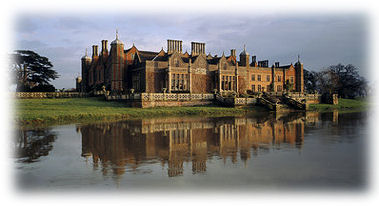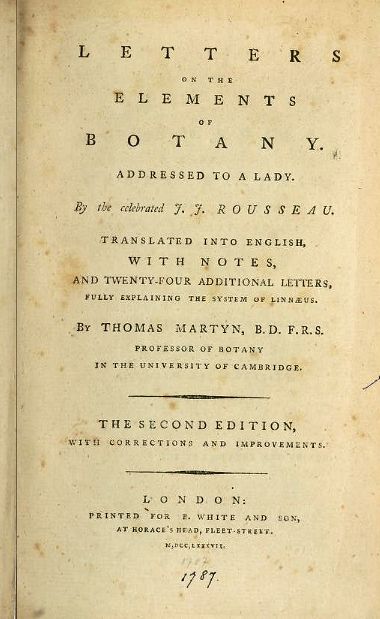From the Library By Len Mullenger Jean-Jacques Rousseau: Julie: ou la
Nouvelle Héloïse ou lettres de deux amants habitants d’une petite
ville aux pieds des Alpes recueillies et publiees (Julie: the
new Heloise: letters from two lovers, living in a small town
at the foot of the Alps) Paris 1813 (first published in 1761)
We need to know who is J-J Rousseau, who is Julie and who is Héloïse?
Rousseau (1712-1778) was a really odd character. If he had been
born 100 years earlier we would have called him a true Rennaissance
man. He was a French Philosopher (although born in Geneva) who seemed
to support totalitarianism and Bertrand Russell considered that he
paved the way for Nazi Germany. As a child he grew up as a Calvinist
with their insistence of the total depravity of man but he felt that
could not really be true so he converted to Catholicism, declaring
that man was born angelic. He wrote later that he had always ‘believed
myself to be, in all things, the best of men’. The truth was that
he liked to go round exposing himself to women and whilst writing
about the lovely innocence of children placed all five of his in a
Parisian orphanage. He was later attacked for this by Voltaire. He
was a scientist, writing a book on Botany which we have in the library.
Rousseau was also a skilled composer who impressed King Louis VI who
offered him a life-long pension – which Rousseau turned down. He also
refused several other honours causing great offence. In his life he
managed to upset everybody including both Protestants and Catholics
and his books were often banned. Although he believed in democracy
he also believed that individuals needed to conform and obey that
which was for the greater good of the state even if it meant giving
up their individual rights, in Rousseau’s words ‘they would be forced
to be free’!. That would lead to totalitarianism. Rousseau ended up
fleeing from country to country staying at one time with David Hume
in England until he fell out with him and returned to France where
he committed suicide. To understand who Héloïse was we might remind ourselves of a recent
scandal in 2012 when a married 28 year old Maths teacher, Jeremy Forrest,
started an affair with a 14 year-old pupil and, when discovered over
a year later, they fled to France. The Girl declared undying love
for him as he was led away to start a five and a half year sentence.
Her love died pretty quickly. But this is not a new phenomenon and
we can go back to 1115. Peter Abelard at that time was a famous teaching
philosopher and head of Notre Dame. Students were drawn from all countries
because of the popularity of his teaching, including Héloïse d’Argenteuil,
the niece of Canon Fulbert. She was a brilliant scholar in Latin,
Greek and Hebrew. Abelard and Héloïse started an affair and Abelard
hoodwinked Canon Fulbert into allowing him to live in the same house.
. Abelard was 36 years old but her age is less clear, probably early
20s. She was already known for her scholarship and practiced as a
physician. Once aware of what was going on Canon Fulbert attempted
to separate them but they continued to meet secretly and eventually
Héloïse became pregnant. Abelard sent her away to live with his sister
in Brittany where she gave birth to a boy she christened Astrolabe
(as in the astronomical instrument). To appease Fulbert, Abelard agreed
to marry Héloïse provided it was kept secret so as not to damage his
career. Abelard then placed Héloïse in a convent supposedly for her
own safety but really to get rid of her. She became a nun and eventually
prioress. Fulbert was furious and one night a group of his friend
set upon Abelard and castrated him. Abelard then became a monk and
after some years started corresponding with Héloïse and the letters
still exist. Héloïse and the nuns were expelled from their nunnery
so Abelard set them up in their own community called The Paraclete
and he became the Abbot. But his teachings were contentious and he
was eventually excommunicated and banned from teaching. Abelard was
the first to die and then Héloïse was eventually to lie with him.
Julie is a novel. It is an epistolary novel which means it is set
as a series of letters. Letters are at once intimate and can express
deep emotions in a way that seems real. Harking back to Héloïse and
Abelard . Julie falls in love with her tutor Saint-Preux. Her father
strongly oppose this as he has in mind a more aristocratic match.
Saint-Preux is forced to leave Julie and travel round the world but
they keep in touch through a series of letters. When he returns he
finds Julie already married to an aristocrat, Wolmar. He finds them
well suited and joins them as a friend. Out of a sense of honour he
does not try to re-establish a relationship with Julie. Julie eventually
dies trying to save a drowning child. The importance of this novel
is that the letters try to explain passion for the first time and
the nature of love and jealousy. This became the bedrock on which
was built generations of romantic fiction. Roussaeu writes in the introduction ‘This book is not meant to circulate
in Society and is suitable for very few readers. The style will put
off people of taste; the contents will alarm strict people; all the
sentiments will be unnatural to those who do not believe in virtue.
It is bound to displease the devout, the libertines, the philosophers:
it is bound to shock gallant women, and scandalize honest ones. Whom
then will it please? Perhaps no-one but me, but very certainly it
will please no-one moderately.’ He underestimated the appeal of this book. It became the biggest
selling book, so much so that the printer could not produce copies
fast enough and had to resort to renting the book out on a daily basis.
There were 70 editions in print before 1800, more than any other novel
in history, Readers were overcome by emotion and Rousseau became the
first celebrity author with women flocking to him. They identified
closely with Julie and her death was traumatic to them. Many simply
would not believe it was a work of fiction seeing their own lives
reflected in the novel. Schopenhauer said Julie was one of the four
greatest novels alongside Tristram Shandy, Wilhelm Meister and Don
Quixote. Julie is huge book. The English edition has over 700 pages including
all the introduction , appendices and notes. The novel itself is about
500 pages. I don’t know how anyone could rent it and read it in a
day. Rousseau had a lovely anecdote about a Lady on her way to the
Opera in her carriage who started to read Julie and never got out,
continuing to read until the following morning.
Return to Index page |



